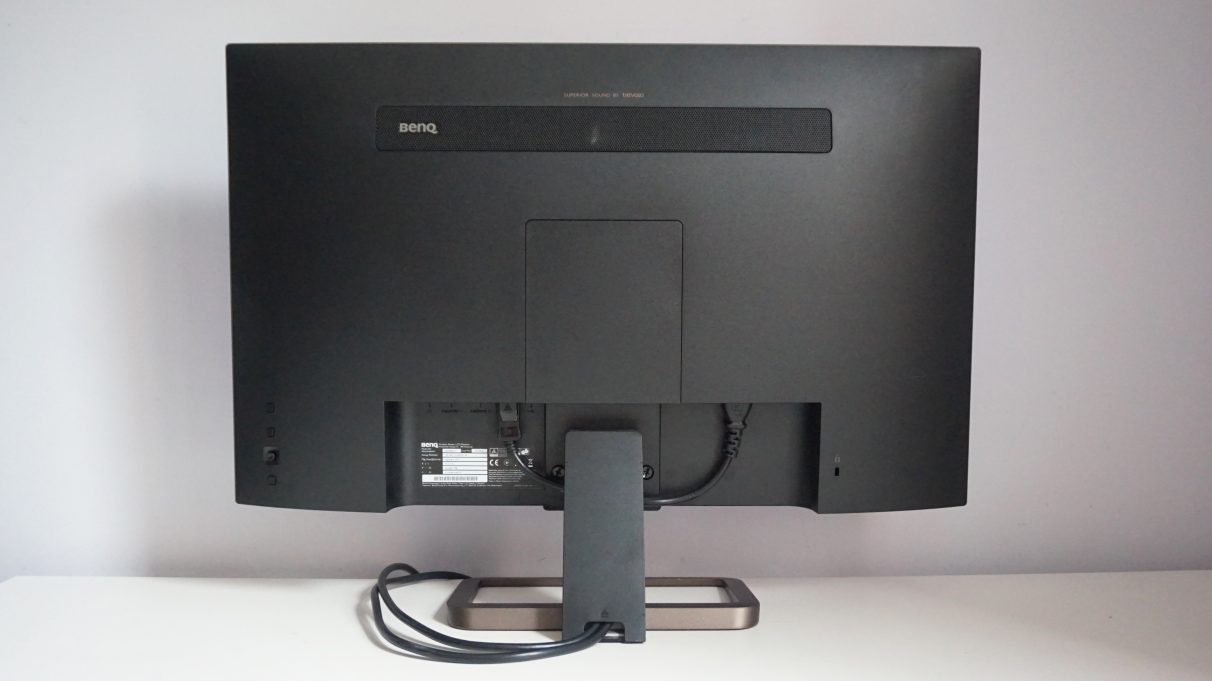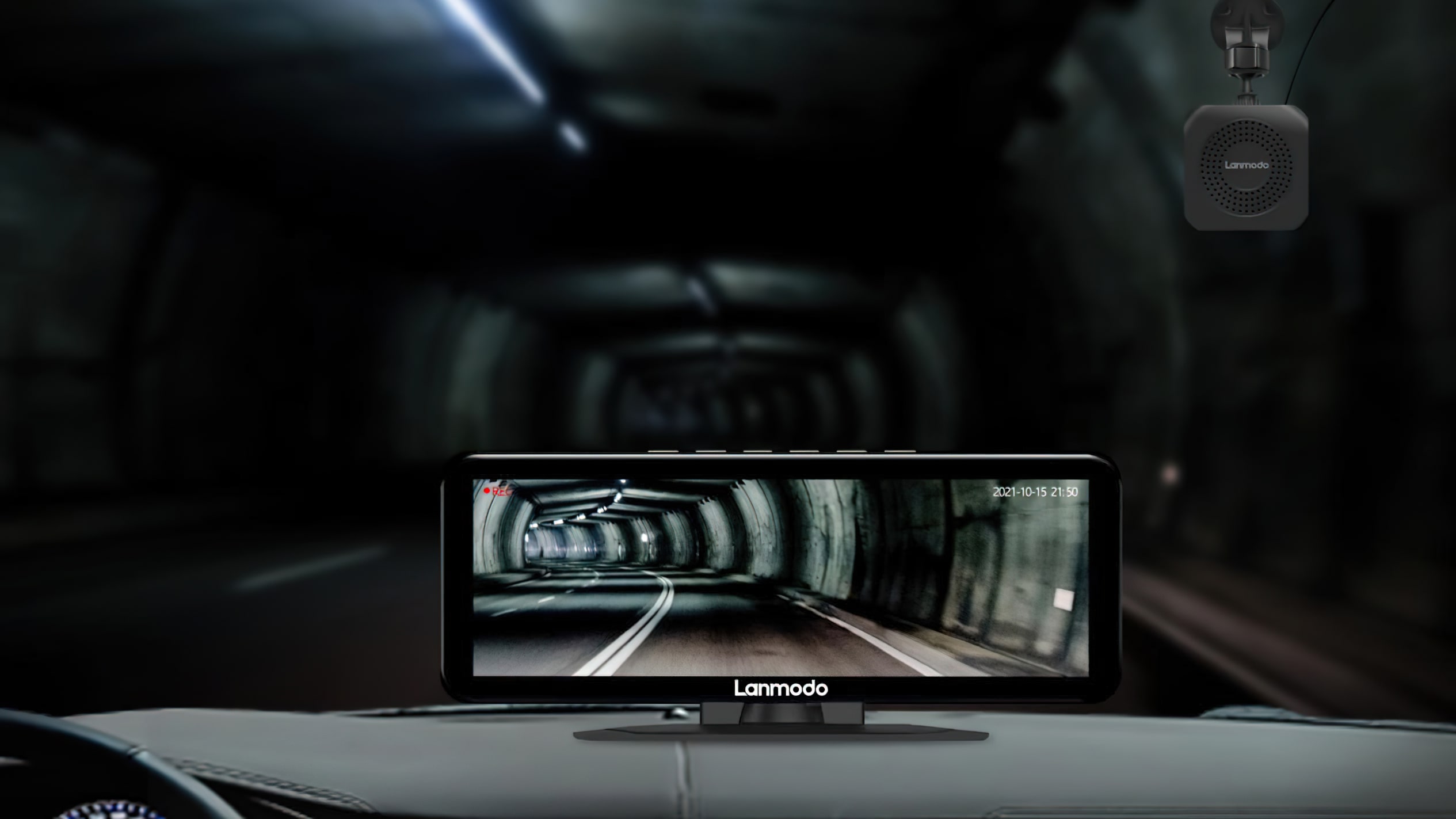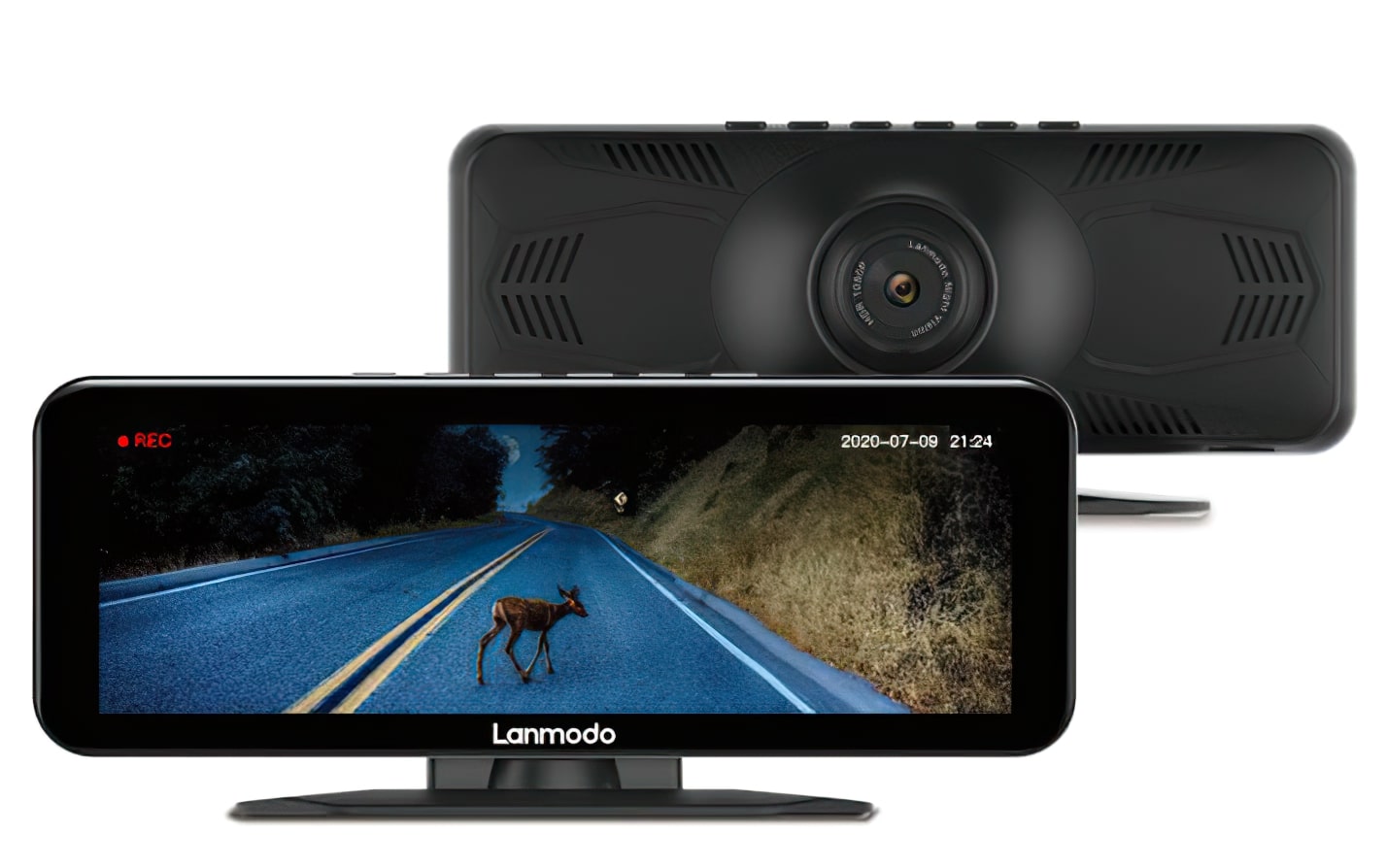
We’re nearly spoiled for alternative on the subject of nice 2560×1440 gaming screens as of late, however the BenQ EX2780Q is one other robust contender that’s worthy of your consideration. For starters, it’s one of many few gaming screens I’ve examined that really has a built-in (albeit very tiny) subwoofer to accompany its pair of 2W audio system, but it surely’s additionally received a brilliant correct IPS panel, a excessive 144Hz refresh charge, AMD Freesync Premium help and considered one of VESA’s DisplayHDR 400 certifications for low-end HDR. In brief, it’s received just about all the things it must problem my present best gaming monitor for 1440p champion, the AOC Agon AG273QX.
Its design is definitely loads much less ‘gamery’ than its AOC rival, though its chunky (and mildly old-fashioned-looking) brown speaker grille and central ambient gentle sensor gained’t be to everybody’s tastes, both. If you may get previous its relatively dated bronzed look, although, then that is one gaming monitor that gained’t be a humiliation to have in your desk. It even has a USB-C port accompanying its pair of HDMI 2.Zero and single DisplayPort 1.Four inputs if you wish to hook it as much as a skinny and light-weight work laptop computer, too, giving it loads of flexibility on the subject of plugging in plenty of units.
BenQ EX2780Q assessment in a nutshell
The good…
- Highly correct IPS panel out of the field
- Freesync Premium help works with Nvidia and AMD GPUs
- Wide vary of inputs, together with USB-C
The dangerous…
- Fixed stand
- Lower distinction than equally priced screens
- HDR is underwhelming
Sadly, that flexibility doesn’t lengthen to its mounted stand. You can, at the least take away its rear panel and thread your monitor cables by means of it for max tidiness, however if you’re spending £425 / $450 on a gaming monitor like this, I’d actually count on a height-adjustable stand as commonplace.
Still, I definitely didn’t have any complaints about its IPS panel, which is just about excellent straight out of the field. On its default settings, which makes use of the Standard color mode and Normal Colour Temperature, my X-Rite ShowPro i1 calibrator confirmed it was already displaying a virtually excellent 99.9% of the sRGB color gamut, and a really spectacular 94.3% of the HDR-grade DCI-P3 gamut. Even the most effective HDR shows solely must hit at the least 90% of the DCI-P3 gamut, so this is superb information certainly, particularly when even the AOC Agon AG273QX and its shut rival, the MSI Optix MAG272CQR, solely had round 88% DCI-P3 protection.
I used to be additionally happy to see an honest distinction ratio of 1070:1 and a fairly low black stage of 0.33cd/m2 (the nearer to 0.00cd/m2, the higher). Admittedly, these outcomes aren’t fairly as spectacular as its AOC and MSI competitors, but it surely’s nonetheless roughly consistent with what I’d count on from an IPS panel. Both the AOC and MSI have VA panels, which have naturally greater distinction ratios and deeper black ranges. Still, I nonetheless felt a bit annoyed after I tried taking part in significantly darkish games on the BenQ EX2780Q equivalent to Close To The Sun and Little Nightmares, and I had actual bother seeing what was onscreen after I was gaming throughout the day.
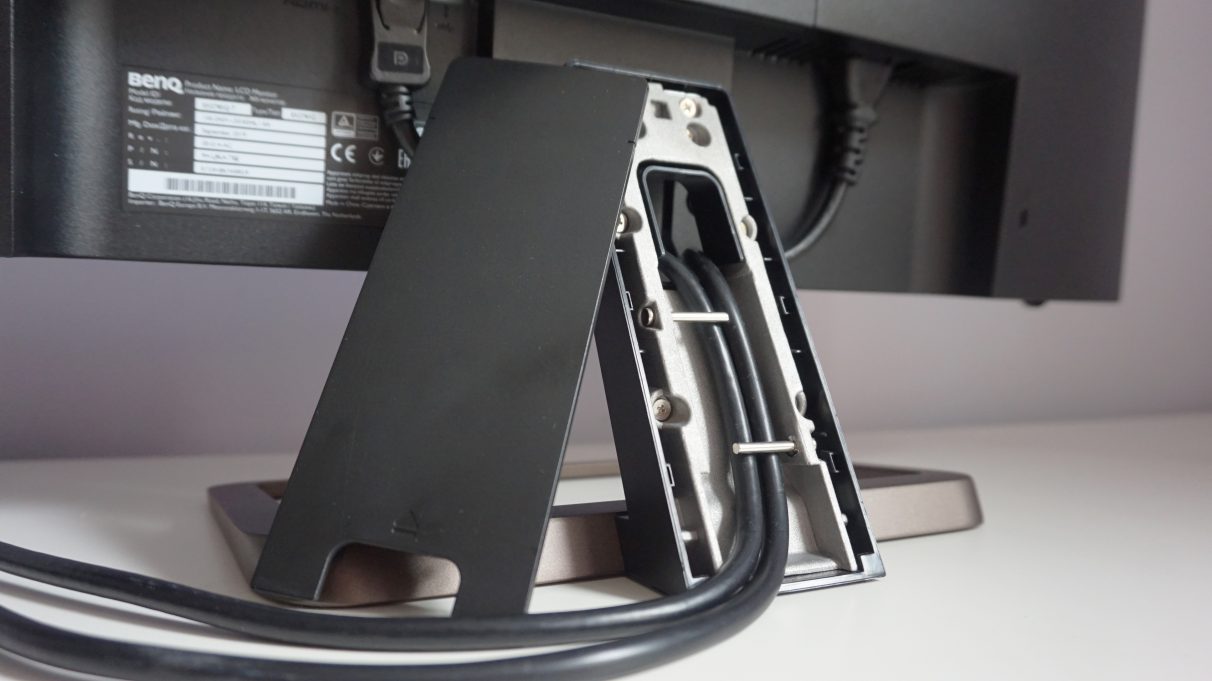
You can take away the rear panel of the BenQ EX2780Q’s stand to assist maintain your cables good and tidy.
Its peak brightness stage of round 357cd/m2 went a way to assist alleviate this, however even messing round with the monitor’s gamma settings didn’t actually repair it. Annoyingly, the monitor’s Black Equalizer setting, which might help brighten darkish pictures onscreen, isn’t out there on its Standard color mode, and I needed to swap over to considered one of its overly grainy Gamer modes earlier than I may make use of it.
Still, after I wasn’t taking part in games set in near-pitch-black environments, the EX2780Q was a positive gaming companion certainly. Colours had been beautiful and wealthy due to these tremendous excessive gamut scores, and blacks seemed deep and inky.
Its HDR help wasn’t an excessive amount of of a ache to get working, both, though the unusual combination of certifications this monitor has is a bit of bit baffling to say the least. It meets VESA’s entry-level DisplayHDR 400 specification, for instance (and I did certainly document a peak brightness of round 450cd/m2 after I switched on HDR in Assassin’s Creed Odyssey), however for no matter cause this doesn’t mechanically make it an AMD Freesync Premium Pro monitor as effectively.
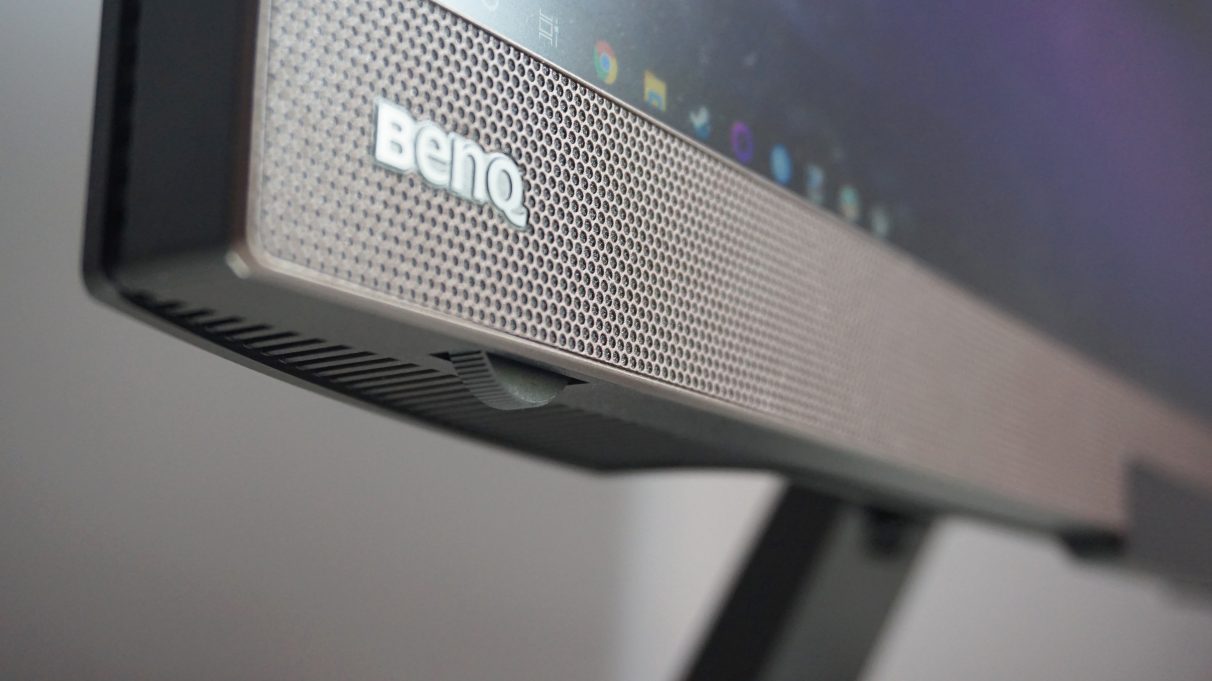
The BenQ EX2780Q comes with a helpful quantity wheel for controlling its 2.1 channel audio system, however you too can use the bundled distant management to vary quantity as effectively.
Instead, it’s only a common Freesync Premium display, which suggests it has AMD’s Low Framerate Compensation tech (LFC) along with its standard variable refresh charge help for easy, tear-free gaming. Indeed, all LFC does is develop the conventional body charge vary in the place Freesync kicks in, permitting you to utilize it at decrease body charges (therefore the identify) than regular Freesync screens.
To grow to be a Freesync Premium Pro monitor, you want all that plus help for HDR and low latency throughout the board, no matter whether or not you’re in HDR or SDR. I can solely think about that the BenQ EX2780Q should fall down not directly on the subject of the latency aspect of issues, however I definitely didn’t have an issue with it throughout the course of my testing. If something, games felt simply as responsive and easy as each different gaming monitor I’ve examined, so I wouldn’t let any of this put you off.
Still, the primary factor is that its HDR help labored fairly easily. When I booted up Assassin’s Creed, it instantly recognised it as an HDR succesful show and I didn’t have to spend ages adjusting the settings to get an excellent image. Other games, equivalent to Final Fantasy XV, required me to change on Windows 10’s HDR settings earlier than boot-up in an effort to fiddle with the in-game HDR settings, however that is fairly widespread throughout all HDR screens.

You get an honest vary of show inputs with the BenQ EX2780Q, together with two HDMI 2.Zero inputs, one DisplayPort 1.4, a USB-C port and a 3.5mm headphone jack.
As for the influence of the monitor’s HDR, that was decidedly extra hit or miss. Assassin’s Creed Odyssey noticed a noticeable raise in each color copy and total brightness, however Final Fantasy XV seemed nigh on similar with or with out it. Colours didn’t pop in the identical manner as Assassin’s Creed, and brilliant areas of the display equivalent to road lamps and the solar didn’t profit from that further 100cd/m2 of brightness you get by switching on its HDR mode both.
Admittedly, this isn’t a lot a flaw of the EX2780Q as it’s all DisplayHDR 400 screens typically. HDR isn’t nearly a vivid, expanded color gamut, in spite of everything. It’s additionally about an elevated luminance vary, and a peak brightness of 450cd/m2 simply isn’t actually sufficient to actually make this facet of HDR sing. After all, there are many non-HDR screens that may hit that type of brightness stage anyway, so it’s not like 450cd/m2 is especially particular within the first place. Instead, to actually admire the complete whack of HDR, it’s essential to put money into a better HDR specification – and to get the identical diploma of HDR as high-end TVs as of late, you really want a monitor with a VESA DisplayHDR 1000 badge.
Naturally, these screens are phenomenally costly, far more so than a 1000cd/m2 TV, and also you simply don’t get this type of HDR spec on a £425 / $450-odd gaming display. As a consequence, practically all 1440p gaming screens as of late merely make do with the entry-level DisplayHDR 400 commonplace as a substitute. It’s not essentially a foul factor, however you’re solely actually getting half of the HDR expertise consequently. Rich colors are beautiful, but it surely’s the brightness a part of HDR that actually makes the distinction in my eyes (actually and figuratively), so it’s simply one thing to remember when you’re hoping for an all-singing, all-dancing HDR display.

The BenQ EX2780Q’s ambient gentle sensor on the entrance of the monitor can mechanically detect your room’s lighting circumstances and alter the display’s color temperature accordingly, serving to to scale back eye pressure. It additionally has a handbook low blue gentle filter mode within the settings, in addition to plenty of different eye care choices within the onboard menu.
On a extra constructive observe, my testing reveals the BenQ EX2780Q’s Freesync tech works completely effectively with AMD and Nvidia graphics playing cards alike, regardless of not being considered one of Nvidia’s formally licensed G-Sync Compatible monitors but. I didn’t see any of the visible defects that may generally happen on screens that don’t cross Nvidia’s numerous checks, equivalent to flickering, blinking, pulsating or off-colours when taking part in games, so it is best to be capable of make use of the monitor’s variable refresh charge tech no matter what sort of graphics card you’ve.
Is it price shopping for over the AOC Agon AG273QX or MSI Optix MAG272CQR, although? Personally, I feel I’d nonetheless favor to have the £430 AOC on my desk, if solely since you get that height-adjustable stand and a better 165Hz refresh charge. I additionally reckon the AOC’s audio system provide mildly higher sound high quality than the BenQ’s 2.1 channel system, though each nonetheless can’t compete with both a correct gaming headset or a pair of devoted audio system. The BenQ’s audio system do an honest job when you actually don’t have anything else, however the sound can get fairly muddy at greater volumes.
The BenQ does, at the least, have the additional advantage of being in inventory for our associates within the US, which sadly isn’t the case for the AOC at time of writing, however even then I’d be tempted by the equally priced £396 / $400 MSI Optix MAG272CQR, if solely once more for that height-adjustable stand and 165Hz refresh charge. It’s not a correct HDR show, all advised, however as I discussed above, DisplayHDR 400 screens are a bit of underwhelming on this division anyway, so that you’re not likely dropping a lot right here.
Still, when you’re completely adamant about having a flat display that doesn’t have a shred of RGB lighting on it, then the BenQ EX2780Q continues to be a really worthwhile alternative. Its panel is superb, it has a variety of ports and it performs properly with all sorts of graphics playing cards. If it had been a smidge cheaper it might be an important funds possibility, however for now, it nonetheless performs second (or third) fiddle to the AOC Agon AG273QX.
Remember, to get the most effective costs on right this moment’s best gaming monitors, be sure you verify our commonly up to date Gaming monitor deals hub for all the newest and best bargains.
